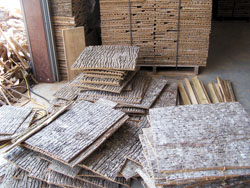
Poplar bark has been used to side buildings in Appalachia for centuries. Buildings in the region can be found with bark siding that's 75 years old or more. Now a company has started marketing the all-natural siding throughout the U.S. and Canada.
"The bark comes from Tulip Poplar trees harvested in the Appalachian Mountains during a limited season each year, " says Danny Heatherly, Barkclad Natural Products. "It provides a durable, low-maintenance and attractive exterior covering. It can also be used to panel interior rooms."
The bark is hand-peeled on site and carried to pallets, while the wood is harvested for the furniture and plywood industries. At the pallet, it's stacked flat to keep it clean, prevent damage and maintain quality. At a special kiln, it's dried at 150 degrees or higher to destroy insects, eggs, larvae and fungi without the use of chemicals. Moisture levels are lowered to between 8 and 12 percent. It's then cut to 18 and 24-in. lengths with varying widths. The Tulip Poplar siding is available in three grades: Interior (5/8 in. thick or less), Premium Standard (3/4 to 1 1/4 in. thick) and Super Premium (1 1/4 to 1 1/2 in. thick).
It's available on 900-lb. pallets or in boxes that hold approximately 30 sq. ft. of bark for use in interior design, furniture and craft projects. This Bark-N-Box is priced per sq. ft. Pricing by the pallet is available from the company. Large sheets of bark sell at a premium price.
Like a pig farmer selling everything but the squeal, Barkclad sells a wide variety of rustic products. Railings and locust poles among them. The also sell Mountain Laurel picket sticks, tobacco stick railings and rustic (rusty) tin. Weathered barn boards are also available from the firm.
